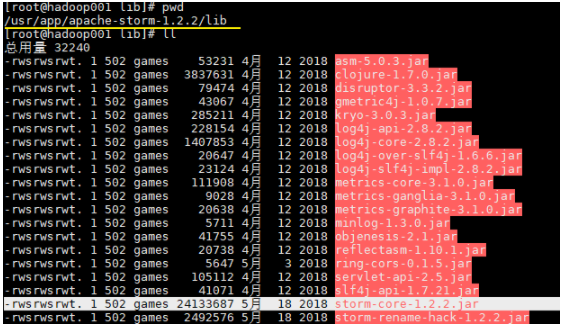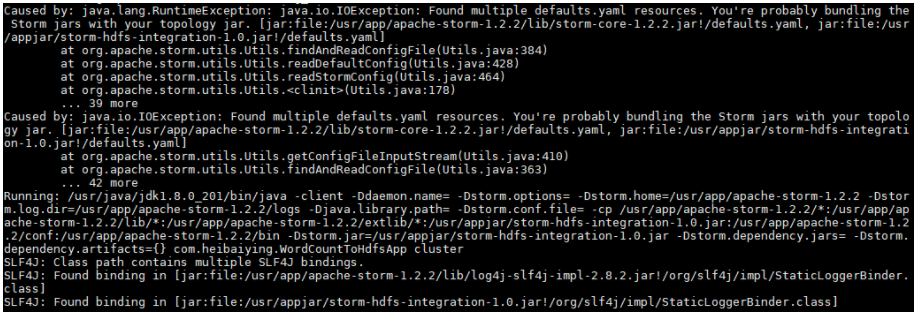## 一、简介
在将 Storm Topology 提交到服务器集群运行时,需要先将项目进行打包。本文主要对比分析各种打包方式,并将打包过程中需要注意的事项进行说明。主要打包方式有以下三种:
* 第一种:不加任何插件,直接使用 mvn package 打包;
* 第二种:使用 maven-assembly-plugin 插件进行打包;
* 第三种:使用 maven-shade-plugin 进行打包。
以下分别进行详细的说明。
## 二、mvn package
### 2.1 mvn package的局限
不在 POM 中配置任何插件,直接使用 `mvn package` 进行项目打包,这对于没有使用外部依赖包的项目是可行的。
但如果项目中使用了第三方 JAR 包,就会出现问题,因为 `mvn package` 打包后的 JAR 中是不含有依赖包的,如果此时你提交到服务器上运行,就会出现找不到第三方依赖的异常。
如果你想采用这种方式进行打包,但是又使用了第三方 JAR,有没有解决办法?答案是有的,这一点在官方文档的[Command Line Client](http://storm.apache.org/releases/2.0.0-SNAPSHOT/Command-line-client.html) 章节有所讲解,主要解决办法如下。
### 2.2 解决办法
在使用 `storm jar` 提交 Topology 时,可以使用如下方式指定第三方依赖:
* 如果第三方 JAR 包在本地,可以使用 `--jars` 指定;
* 如果第三方 JAR 包在远程中央仓库,可以使用 `--artifacts` 指定,此时如果想要排除某些依赖,可以使用 `^` 符号。指定后 Storm 会自动到中央仓库进行下载,然后缓存到本地;
* 如果第三方 JAR 包在其他仓库,还需要使用 `--artifactRepositories` 指明仓库地址,库名和地址使用 `^` 符号分隔。
以下是一个包含上面三种情况的命令示例:
~~~
./bin/storm jar example/storm-starter/storm-starter-topologies-*.jar \
org.apache.storm.starter.RollingTopWords blobstore-remote2 remote \
--jars "./external/storm-redis/storm-redis-1.1.0.jar,./external/storm-kafka/storm-kafka-1.1.0.jar" \
--artifacts "redis.clients:jedis:2.9.0,org.apache.kafka:kafka_2.10:0.8.2.2^org.slf4j:slf4j-log4j12" \
--artifactRepositories "jboss-repository^http://repository.jboss.com/maven2, \
HDPRepo^http://repo.hortonworks.com/content/groups/public/"
~~~
这种方式是建立在你能够连接到外网的情况下,如果你的服务器不能连接外网,或者你希望能把项目直接打包成一个 `ALL IN ONE` 的 JAR,即包含所有相关依赖,此时可以采用下面介绍的两个插件。
## 三、maven-assembly-plugin插件
maven-assembly-plugin 是官方文档中介绍的打包方法,来源于官方文档:[Running Topologies on a Production Cluster](http://storm.apache.org/releases/2.0.0-SNAPSHOT/Running-topologies-on-a-production-cluster.html)
> If you're using Maven, the [Maven Assembly Plugin](http://maven.apache.org/plugins/maven-assembly-plugin/) can do the packaging for you. Just add this to your pom.xml:
>
> ~~~
> <plugin>
> <artifactId>maven-assembly-plugin</artifactId>
> <configuration>
> <descriptorRefs>
> <descriptorRef>jar-with-dependencies</descriptorRef>
> </descriptorRefs>
> <archive>
> <manifest>
> <mainClass>com.path.to.main.Class</mainClass>
> </manifest>
> </archive>
> </configuration>
> </plugin>
> ~~~
>
> Then run mvn assembly:assembly to get an appropriately packaged jar. Make sure you [exclude](http://maven.apache.org/plugins/maven-assembly-plugin/examples/single/including-and-excluding-artifacts.html) the Storm jars since the cluster already has Storm on the classpath.
官方文档主要说明了以下几点:
* 使用 maven-assembly-plugin 可以把所有的依赖一并打入到最后的 JAR 中;
* 需要排除掉 Storm 集群环境中已经提供的 Storm jars;
* 通过 `<mainClass>` 标签指定主入口类;
* 通过 `<descriptorRef>` 标签指定打包相关配置。
`jar-with-dependencies` 是 Maven[预定义](http://maven.apache.org/plugins/maven-assembly-plugin/descriptor-refs.html#jar-with-dependencies) 的一种最基本的打包配置,其 XML 文件如下:
~~~
<assembly xmlns="http://maven.apache.org/ASSEMBLY/2.0.0"
xmlns:xsi="http://www.w3.org/2001/XMLSchema-instance"
xsi:schemaLocation="http://maven.apache.org/ASSEMBLY/2.0.0
http://maven.apache.org/xsd/assembly-2.0.0.xsd">
<id>jar-with-dependencies</id>
<formats>
<format>jar</format>
</formats>
<includeBaseDirectory>false</includeBaseDirectory>
<dependencySets>
<dependencySet>
<outputDirectory>/</outputDirectory>
<useProjectArtifact>true</useProjectArtifact>
<unpack>true</unpack>
<scope>runtime</scope>
</dependencySet>
</dependencySets>
</assembly>
~~~
我们可以通过对该配置文件进行拓展,从而实现更多的功能,比如排除指定的 JAR 等。使用示例如下:
### 1\. 引入插件
在 POM.xml 中引入插件,并指定打包格式的配置文件为 `assembly.xml`(名称可自定义):
~~~
<build>
<plugins>
<plugin>
<artifactId>maven-assembly-plugin</artifactId>
<configuration>
<descriptors>
<descriptor>src/main/resources/assembly.xml</descriptor>
</descriptors>
<archive>
<manifest>
<mainClass>com.heibaiying.wordcount.ClusterWordCountApp</mainClass>
</manifest>
</archive>
</configuration>
</plugin>
</plugins>
</build>
~~~
`assembly.xml` 拓展自 `jar-with-dependencies.xml`,使用了 `<excludes>` 标签排除 Storm jars,具体内容如下:
~~~
<assembly xmlns="http://maven.apache.org/ASSEMBLY/2.0.0"
xmlns:xsi="http://www.w3.org/2001/XMLSchema-instance"
xsi:schemaLocation="http://maven.apache.org/ASSEMBLY/2.0.0
http://maven.apache.org/xsd/assembly-2.0.0.xsd">
<id>jar-with-dependencies</id>
<!--指明打包方式-->
<formats>
<format>jar</format>
</formats>
<includeBaseDirectory>false</includeBaseDirectory>
<dependencySets>
<dependencySet>
<outputDirectory>/</outputDirectory>
<useProjectArtifact>true</useProjectArtifact>
<unpack>true</unpack>
<scope>runtime</scope>
<!--排除 storm 环境中已经提供的 storm-core-->
<excludes>
<exclude>org.apache.storm:storm-core</exclude>
</excludes>
</dependencySet>
</dependencySets>
</assembly>
~~~
> 在配置文件中不仅可以排除依赖,还可以排除指定的文件,更多的配置规则可以参考官方文档:[Descriptor Format](http://maven.apache.org/plugins/maven-assembly-plugin/assembly.html#)
### 2\. 打包命令
采用 maven-assembly-plugin 进行打包时命令如下:
~~~
# mvn assembly:assembly
~~~
打包后会同时生成两个 JAR 包,其中后缀为 `jar-with-dependencies` 是含有第三方依赖的 JAR 包,后缀是由 `assembly.xml` 中 `<id>` 标签指定的,可以自定义修改。提交该 JAR 到集群环境即可直接使用。

## 四、maven-shade-plugin插件
### 4.1 官方文档说明
第三种方式是使用 maven-shade-plugin,既然已经有了 maven-assembly-plugin,为什么还需要 maven-shade-plugin,这一点在官方文档中也是有所说明的,来自于官方对 HDFS 整合讲解的章节[Storm HDFS Integration](http://storm.apache.org/releases/2.0.0-SNAPSHOT/storm-hdfs.html),原文如下:
> When packaging your topology, it's important that you use the [maven-shade-plugin](http://storm.apache.org/releases/2.0.0-SNAPSHOT/storm-hdfs.html) as opposed to the [maven-assembly-plugin](http://storm.apache.org/releases/2.0.0-SNAPSHOT/storm-hdfs.html).
>
> The shade plugin provides facilities for merging JAR manifest entries, which the hadoop client leverages for URL scheme resolution.
>
> If you experience errors such as the following:
>
> ~~~
> java.lang.RuntimeException: Error preparing HdfsBolt: No FileSystem for scheme: hdfs
> ~~~
>
> it's an indication that your topology jar file isn't packaged properly.
>
> If you are using maven to create your topology jar, you should use the following `maven-shade-plugin` configuration to create your topology jar。
这里第一句就说的比较清晰,在集成 HDFS 时候,你必须使用 maven-shade-plugin 来代替 maven-assembly-plugin,否则会抛出 RuntimeException 异常。
采用 maven-shade-plugin 打包有很多好处,比如你的工程依赖很多的 JAR 包,而被依赖的 JAR 又会依赖其他的 JAR 包,这样,当工程中依赖到不同的版本的 JAR 时,并且 JAR 中具有相同名称的资源文件时,shade 插件会尝试将所有资源文件打包在一起时,而不是和 assembly 一样执行覆盖操作。
### 4.2 配置
采用 `maven-shade-plugin` 进行打包时候,配置示例如下:
~~~
<plugin>
<groupId>org.apache.maven.plugins</groupId>
<artifactId>maven-shade-plugin</artifactId>
<configuration>
<createDependencyReducedPom>true</createDependencyReducedPom>
<filters>
<filter>
<artifact>*:*</artifact>
<excludes>
<exclude>META-INF/*.SF</exclude>
<exclude>META-INF/*.sf</exclude>
<exclude>META-INF/*.DSA</exclude>
<exclude>META-INF/*.dsa</exclude>
<exclude>META-INF/*.RSA</exclude>
<exclude>META-INF/*.rsa</exclude>
<exclude>META-INF/*.EC</exclude>
<exclude>META-INF/*.ec</exclude>
<exclude>META-INF/MSFTSIG.SF</exclude>
<exclude>META-INF/MSFTSIG.RSA</exclude>
</excludes>
</filter>
</filters>
<artifactSet>
<excludes>
<exclude>org.apache.storm:storm-core</exclude>
</excludes>
</artifactSet>
</configuration>
<executions>
<execution>
<phase>package</phase>
<goals>
<goal>shade</goal>
</goals>
<configuration>
<transformers>
<transformer
implementation="org.apache.maven.plugins.shade.resource.ServicesResourceTransformer"/>
<transformer
implementation="org.apache.maven.plugins.shade.resource.ManifestResourceTransformer">
</transformer>
</transformers>
</configuration>
</execution>
</executions>
</plugin>
~~~
以上配置示例来源于 Storm Github,这里做一下说明:
在上面的配置中,排除了部分文件,这是因为有些 JAR 包生成时,会使用 jarsigner 生成文件签名(完成性校验),分为两个文件存放在 META-INF 目录下:
* a signature file, with a .SF extension;
* a signature block file, with a .DSA, .RSA, or .EC extension;
如果某些包的存在重复引用,这可能会导致在打包时候出现 `Invalid signature file digest for Manifest main attributes` 异常,所以在配置中排除这些文件。
### 4.3 打包命令
使用 maven-shade-plugin 进行打包的时候,打包命令和普通的一样:
~~~
# mvn package
~~~
打包后会生成两个 JAR 包,提交到服务器集群时使用 `非 original` 开头的 JAR。

## 五、结论
通过以上三种打包方式的详细介绍,这里给出最后的结论:**建议使用 maven-shade-plugin 插件进行打包**,因为其通用性最强,操作最简单,并且 Storm Github 中所有[examples](https://github.com/apache/storm/tree/master/examples) 都是采用该方式进行打包。
## 六、打包注意事项
无论采用任何打包方式,都必须排除集群环境中已经提供的 storm jars。这里比较典型的是 storm-core,其在安装目录的 lib 目录下已经存在。

如果你不排除 storm-core,通常会抛出下面的异常:
~~~
Caused by: java.lang.RuntimeException: java.io.IOException: Found multiple defaults.yaml resources.
You're probably bundling the Storm jars with your topology jar.
[jar:file:/usr/app/apache-storm-1.2.2/lib/storm-core-1.2.2.jar!/defaults.yaml,
jar:file:/usr/appjar/storm-hdfs-integration-1.0.jar!/defaults.yaml]
at org.apache.storm.utils.Utils.findAndReadConfigFile(Utils.java:384)
at org.apache.storm.utils.Utils.readDefaultConfig(Utils.java:428)
at org.apache.storm.utils.Utils.readStormConfig(Utils.java:464)
at org.apache.storm.utils.Utils.<clinit>(Utils.java:178)
... 39 more
~~~

作者:heibaiying
链接:https://juejin.cn/post/6844903950034944014
来源:掘金
著作权归作者所有。商业转载请联系作者获得授权,非商业转载请注明出处。
- 一.JVM
- 1.1 java代码是怎么运行的
- 1.2 JVM的内存区域
- 1.3 JVM运行时内存
- 1.4 JVM内存分配策略
- 1.5 JVM类加载机制与对象的生命周期
- 1.6 常用的垃圾回收算法
- 1.7 JVM垃圾收集器
- 1.8 CMS垃圾收集器
- 1.9 G1垃圾收集器
- 2.面试相关文章
- 2.1 可能是把Java内存区域讲得最清楚的一篇文章
- 2.0 GC调优参数
- 2.1GC排查系列
- 2.2 内存泄漏和内存溢出
- 2.2.3 深入理解JVM-hotspot虚拟机对象探秘
- 1.10 并发的可达性分析相关问题
- 二.Java集合架构
- 1.ArrayList深入源码分析
- 2.Vector深入源码分析
- 3.LinkedList深入源码分析
- 4.HashMap深入源码分析
- 5.ConcurrentHashMap深入源码分析
- 6.HashSet,LinkedHashSet 和 LinkedHashMap
- 7.容器中的设计模式
- 8.集合架构之面试指南
- 9.TreeSet和TreeMap
- 三.Java基础
- 1.基础概念
- 1.1 Java程序初始化的顺序是怎么样的
- 1.2 Java和C++的区别
- 1.3 反射
- 1.4 注解
- 1.5 泛型
- 1.6 字节与字符的区别以及访问修饰符
- 1.7 深拷贝与浅拷贝
- 1.8 字符串常量池
- 2.面向对象
- 3.关键字
- 4.基本数据类型与运算
- 5.字符串与数组
- 6.异常处理
- 7.Object 通用方法
- 8.Java8
- 8.1 Java 8 Tutorial
- 8.2 Java 8 数据流(Stream)
- 8.3 Java 8 并发教程:线程和执行器
- 8.4 Java 8 并发教程:同步和锁
- 8.5 Java 8 并发教程:原子变量和 ConcurrentMap
- 8.6 Java 8 API 示例:字符串、数值、算术和文件
- 8.7 在 Java 8 中避免 Null 检查
- 8.8 使用 Intellij IDEA 解决 Java 8 的数据流问题
- 四.Java 并发编程
- 1.线程的实现/创建
- 2.线程生命周期/状态转换
- 3.线程池
- 4.线程中的协作、中断
- 5.Java锁
- 5.1 乐观锁、悲观锁和自旋锁
- 5.2 Synchronized
- 5.3 ReentrantLock
- 5.4 公平锁和非公平锁
- 5.3.1 说说ReentrantLock的实现原理,以及ReentrantLock的核心源码是如何实现的?
- 5.5 锁优化和升级
- 6.多线程的上下文切换
- 7.死锁的产生和解决
- 8.J.U.C(java.util.concurrent)
- 0.简化版(快速复习用)
- 9.锁优化
- 10.Java 内存模型(JMM)
- 11.ThreadLocal详解
- 12 CAS
- 13.AQS
- 0.ArrayBlockingQueue和LinkedBlockingQueue的实现原理
- 1.DelayQueue的实现原理
- 14.Thread.join()实现原理
- 15.PriorityQueue 的特性和原理
- 16.CyclicBarrier的实际使用场景
- 五.Java I/O NIO
- 1.I/O模型简述
- 2.Java NIO之缓冲区
- 3.JAVA NIO之文件通道
- 4.Java NIO之套接字通道
- 5.Java NIO之选择器
- 6.基于 Java NIO 实现简单的 HTTP 服务器
- 7.BIO-NIO-AIO
- 8.netty(一)
- 9.NIO面试题
- 六.Java设计模式
- 1.单例模式
- 2.策略模式
- 3.模板方法
- 4.适配器模式
- 5.简单工厂
- 6.门面模式
- 7.代理模式
- 七.数据结构和算法
- 1.什么是红黑树
- 2.二叉树
- 2.1 二叉树的前序、中序、后序遍历
- 3.排序算法汇总
- 4.java实现链表及链表的重用操作
- 4.1算法题-链表反转
- 5.图的概述
- 6.常见的几道字符串算法题
- 7.几道常见的链表算法题
- 8.leetcode常见算法题1
- 9.LRU缓存策略
- 10.二进制及位运算
- 10.1.二进制和十进制转换
- 10.2.位运算
- 11.常见链表算法题
- 12.算法好文推荐
- 13.跳表
- 八.Spring 全家桶
- 1.Spring IOC
- 2.Spring AOP
- 3.Spring 事务管理
- 4.SpringMVC 运行流程和手动实现
- 0.Spring 核心技术
- 5.spring如何解决循环依赖问题
- 6.springboot自动装配原理
- 7.Spring中的循环依赖解决机制中,为什么要三级缓存,用二级缓存不够吗
- 8.beanFactory和factoryBean有什么区别
- 九.数据库
- 1.mybatis
- 1.1 MyBatis-# 与 $ 区别以及 sql 预编译
- Mybatis系列1-Configuration
- Mybatis系列2-SQL执行过程
- Mybatis系列3-之SqlSession
- Mybatis系列4-之Executor
- Mybatis系列5-StatementHandler
- Mybatis系列6-MappedStatement
- Mybatis系列7-参数设置揭秘(ParameterHandler)
- Mybatis系列8-缓存机制
- 2.浅谈聚簇索引和非聚簇索引的区别
- 3.mysql 证明为什么用limit时,offset很大会影响性能
- 4.MySQL中的索引
- 5.数据库索引2
- 6.面试题收集
- 7.MySQL行锁、表锁、间隙锁详解
- 8.数据库MVCC详解
- 9.一条SQL查询语句是如何执行的
- 10.MySQL 的 crash-safe 原理解析
- 11.MySQL 性能优化神器 Explain 使用分析
- 12.mysql中,一条update语句执行的过程是怎么样的?期间用到了mysql的哪些log,分别有什么作用
- 十.Redis
- 0.快速复习回顾Redis
- 1.通俗易懂的Redis数据结构基础教程
- 2.分布式锁(一)
- 3.分布式锁(二)
- 4.延时队列
- 5.位图Bitmaps
- 6.Bitmaps(位图)的使用
- 7.Scan
- 8.redis缓存雪崩、缓存击穿、缓存穿透
- 9.Redis为什么是单线程、及高并发快的3大原因详解
- 10.布隆过滤器你值得拥有的开发利器
- 11.Redis哨兵、复制、集群的设计原理与区别
- 12.redis的IO多路复用
- 13.相关redis面试题
- 14.redis集群
- 十一.中间件
- 1.RabbitMQ
- 1.1 RabbitMQ实战,hello world
- 1.2 RabbitMQ 实战,工作队列
- 1.3 RabbitMQ 实战, 发布订阅
- 1.4 RabbitMQ 实战,路由
- 1.5 RabbitMQ 实战,主题
- 1.6 Spring AMQP 的 AMQP 抽象
- 1.7 Spring AMQP 实战 – 整合 RabbitMQ 发送邮件
- 1.8 RabbitMQ 的消息持久化与 Spring AMQP 的实现剖析
- 1.9 RabbitMQ必备核心知识
- 2.RocketMQ 的几个简单问题与答案
- 2.Kafka
- 2.1 kafka 基础概念和术语
- 2.2 Kafka的重平衡(Rebalance)
- 2.3.kafka日志机制
- 2.4 kafka是pull还是push的方式传递消息的?
- 2.5 Kafka的数据处理流程
- 2.6 Kafka的脑裂预防和处理机制
- 2.7 Kafka中partition副本的Leader选举机制
- 2.8 如果Leader挂了的时候,follower没来得及同步,是否会出现数据不一致
- 2.9 kafka的partition副本是否会出现脑裂情况
- 十二.Zookeeper
- 0.什么是Zookeeper(漫画)
- 1.使用docker安装Zookeeper伪集群
- 3.ZooKeeper-Plus
- 4.zk实现分布式锁
- 5.ZooKeeper之Watcher机制
- 6.Zookeeper之选举及数据一致性
- 十三.计算机网络
- 1.进制转换:二进制、八进制、十六进制、十进制之间的转换
- 2.位运算
- 3.计算机网络面试题汇总1
- 十四.Docker
- 100.面试题收集合集
- 1.美团面试常见问题总结
- 2.b站部分面试题
- 3.比心面试题
- 4.腾讯面试题
- 5.哈罗部分面试
- 6.笔记
- 十五.Storm
- 1.Storm和流处理简介
- 2.Storm 核心概念详解
- 3.Storm 单机版本环境搭建
- 4.Storm 集群环境搭建
- 5.Storm 编程模型详解
- 6.Storm 项目三种打包方式对比分析
- 7.Storm 集成 Redis 详解
- 8.Storm 集成 HDFS 和 HBase
- 9.Storm 集成 Kafka
- 十六.Elasticsearch
- 1.初识ElasticSearch
- 2.文档基本CRUD、集群健康检查
- 3.shard&replica
- 4.document核心元数据解析及ES的并发控制
- 5.document的批量操作及数据路由原理
- 6.倒排索引
- 十七.分布式相关
- 1.分布式事务解决方案一网打尽
- 2.关于xxx怎么保证高可用的问题
- 3.一致性hash原理与实现
- 4.微服务注册中心 Nacos 比 Eureka的优势
- 5.Raft 协议算法
- 6.为什么微服务架构中需要网关
- 0.CAP与BASE理论
- 十八.Dubbo
- 1.快速掌握Dubbo常规应用
- 2.Dubbo应用进阶
- 3.Dubbo调用模块详解
- 4.Dubbo调用模块源码分析
- 6.Dubbo协议模块
